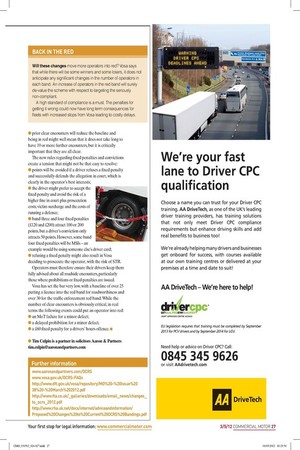Red alert
Page 19

Page 20

If you've noticed an error in this article please click here to report it so we can fix it.
Planned changes to the OCRS system mean operators must tighten up their compliance systems or risk more roadside stops
Words: Tim Culpin
Vosa has delayed a revision of the OCRS (Operator Compliance Risk Score) system due to technical issues. The changes had been due to come into force on 30 April. While it’s a case of ‘watch this space’ for now, it’s worth setting out how the changes will affect operators.
The traffic light model remains and scores still fall somewhere in the spectrum between green and red, with those most likely to be targeted for a roadside stop falling within the red category. However, the changes could have significant implications for all transport firms.
The changes
Predictive scoring, which creates a score for operators who have had no encounters with Vosa, is to be removed and will be replaced by introducing a new grey band for all operators who have had no encounters in the past three years.
It is important for operators to understand where this new band sits in terms of Vosa’s targeting of vehicles: ● traffic offences fall between red and amber – examples include overloading, speeding, driving through red lights; ● roadworthiness offences fall between amber and green.
Banding will now be based on the baseline figure and not on a league table. The baseline figure will be calculated each Friday (available on the following Sunday) by dividing the total points by the total number of operator encounters with Vosa over a three-year period. While the period is being extended from two to three years, points will be weighted by age. This means that a roadside offence has less effect on the haulier’s OCRS rating as time passes: ● encounters less than 12 months old – full weighting; ● 12-24 months old – 0.75 weighting; ● 24-36 months old – 0.5 weighting.
Prohibitions and test failures are now all standardised, which means operators will be issued with a set amount of points depending on the type of infringement that has occurred.
Points for fixed penalties will now also be included in the OCRS calculation: ● a fixed penalty of £120 will add 100 points to an operator’s OCRS. The banding Vosa has currently issued means that if such an event is a first encounter for that licence, then the operator’s OCRS will immediately go to red for the category – roadworthiness or traffic – to which the penalty relates; ● the operator will need a further three clear roadside encounters to reduce the baseline score to 25 or 30 points and return to amber. A further nine or 19 clear encounters are needed to get into green; ● if an encounter results in a fixed penalty and a prohibition then only the prohibition attracts the points; ● points are attached to a fixed penalty on its acceptance by the operator, not on its issue.
Straight-to-red events
Certain events will be straight-to-red (STR) for a period of six or 12 months: ● if an operator is convicted for any offence or if a Most Serious Infringement (MSI) is detected, its OCRS will automatically be red for 12 months for a conviction or six months for an MSI – irrespective of the operator’s baseline score; ● the conviction of a driver does not trigger an STR, but it does attract points; ● STR will place vehicles immediately into the red high risk category and they will be prone to more roadside inspections; ● at the end of that period, the OCRS will be determined by the operator’s then current baseline points; ● with 600 points for a single conviction, operators would need 23 clear encounters to move their roadworthiness baseline score out of the red band, or 19 clear encounters to move their traffic baseline score out of the red band; ● prior clear encounters will reduce the baseline and being in red might well mean that it does not take long to have 19 or more further encounters, but it is critically important that they are all clear.
The new rules regarding fixed penalties and convictions create a tension that might not be that easy to resolve: ● points will be avoided if a driver refuses a fixed penalty and successfully defends the allegation in court, which is clearly in the operator’s best interests; ● the driver might prefer to accept the fixed penalty and avoid the risk of a higher fine in court plus prosecution costs, victim surcharge and the costs of running a defence; ● band three and four fixed penalties (£120 and £200) attract 100 or 200 points, but a driver’s conviction only attracts 50 points. However, some band four fixed penalties will be MSIs – an example would be using someone else’s driver card; ● refusing a fixed penalty might also result in Vosa deciding to prosecute the operator, with the risk of STR.
Operators must therefore ensure their drivers keep them fully advised about all roadside encounters, particularly those where prohibitions or fixed penalties are issued.
Vosa has set the bar very low, with a baseline of over 25 putting a licence into the red band for roadworthiness and over 30 for the traffic enforcement red band. While the number of clear encounters is obviously critical, in real terms the following events could put an operator into red: ● an MoT failure for a minor defect; ● a delayed prohibition for a minor defect; ● a £60 fixed penalty for a drivers’ hours offence. ■ ● Tim Culpin is a partner in solicitors Aaron & Partners tim.culpin@aaronandpartners.com










































